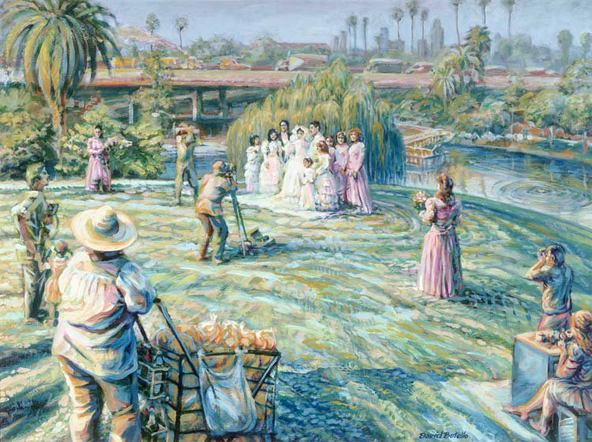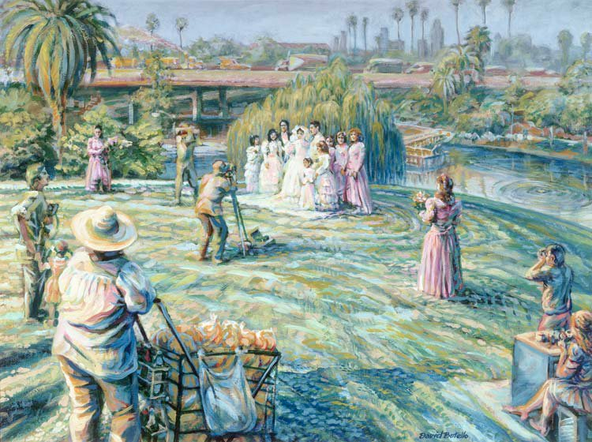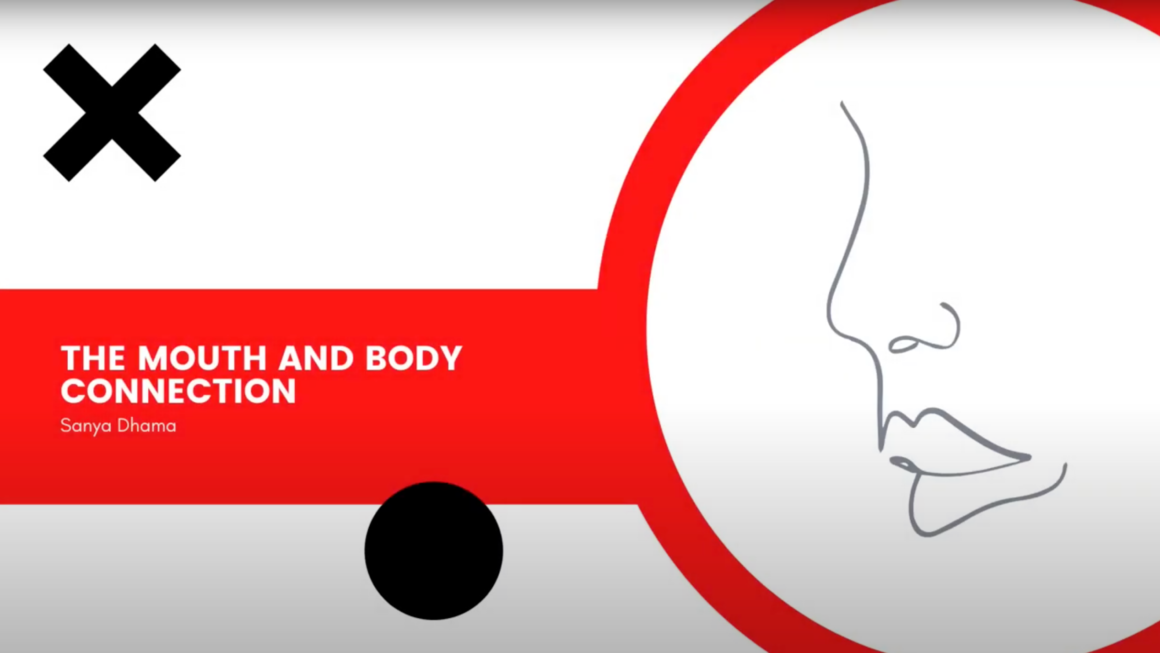
David Botello’s Wedding Photos- Hollenbeck Park
Wedding Photos- Hollenbeck Park was created by David Botello in 1990 in Southern California as part of the Chicano Collection; it is now a part of Cheech Marin’s art collection. The piece is an oil painting that utilizes visual textures to create contrasts between the different elements of nature and to create a contrast between the nature and industrial side of the scenery.
The piece by Botello portrays a couple taking their wedding pictures with family in a serene park: includes a gentle river, a variety of green and luscious vegetation, but also seems to be surrounded by the bustling life of society, as depicted by the highway behind the couple. To understand the piece, we have to know the significance of the highway. At the time (after the 1950s) in East Los Angeles (being home to the second largest population of Mexican immigrants), the constructions of highways were occurring: mass construction. Graffiti, murals, and local advertisements that were in Spanish were plastered on the sides of these highways, bringing in Mexican and Latin American culture. Yet, there were frustrations surrounding the construction, and even after revolts, there would end up being 7 freeways, overwhelming the city of East Los Angeles. Even though the Eastern Los Angeles population got the hard end of the construction, they didn’t have much use for it. It was mostly for people trying to get through the city, resulting in highways all around, but not useful for, the locals. In addition, Mexican-Americans barely even left the proximity of their homes due to work being domestic and there being racial segregation and stigmas that didn’t allow for proper work or work that demanded a commute on the highways. The highway construction project was also seen as a way to get rid of the “scums” (including the immigrant, homeless, and poor population). The piece is very political, as it proves that the Los Angeles legislation did not care for their Mexican population. The painting is also a genre scene, depicting the common, yet momentous, event that is marriage and the preceding wedding photos that serve as memories for a lifetime. The photographer in the painting strategically places the family in front of a large willow tree that covers the background of the highway and numerous cars. However, the painter still includes the highway. Botello colors the highway in a light, pastel pink that ties into the bridesmaids’ dresses. The pink highway is a contrast to the grey, mundane roads that are normally a part of society. By coloring it in this way, Botello links Mexican-American culture with the anger from the highway. By including it in general, he shows how worthless the highway was and how much of an impact it had: an obstacle in the couple’s photos and a burden in everyday life during construction. The piece is sincere and serene, with the subjects portrayed in a modest light through the harshness of society.
My path of vision initially went to the family standing in front of the willow tree. Then it went to the hunched photographer, trying to get the perfect angle for the couple’s wedding photos. The third thing I saw was the highway in the background. My first impression of the work was that it was calm (lacking energy), had a sense of normalcy (serene and placid), and was luscious and wholesome. When describing the work, the elements do support my initial impression. The lack of energy correlates to the defeated Mexicans (in terms of defeating racial segregation), the normalcy and serenity correlates to the hidden pockets of peace found within bustling Los Angeles, and the lusciousness correlates with Mexican culture.
The composition includes some hues that are more intense than the others. The green hues of the grass, trees, and of the general nature scenery are intense and contrast with the pale pink and blue, grey background. The colors are generally warm, with the varieties of green and hints of red, orange, and yellow. The green and white colors seem to come forward, while the pink, blues, and browns seem to recede. The artist plays around a lot with different values. He uses dark and light shades of green, blue, and orange to show more texture.
The artist uses a painterly style, the trees blurring into the background and the figures almost being a part of the scenery. The artist emphasizes horizontal lines, with the high way, pathway, and river. The horizontal lines provide stability and, therefore, the same sense of serenity and normalcy. The piece also has a sense of diagonal balance. From the viewpoint of the bystander with the hat, there is a woman in pink on both sides, a secondary photographer on both sides, other bystanders in brown and red tones, and the continuation of the river and highway on the left and right halves of the work. The lines are rhythmic, as they continue throughout the whole piece, and are carefully composed within the piece due to slight curves in the lines bringing flow. The lines provide a separation from the serenity of the family taking pictures and the back half to the two thirds of the piece portraying the outside life and troubles of East Los Angeles.
There is fairly even lighting, as the whole piece is vibrant and bright. The light is all coming from the same source: the sun on the top left of the scene. This is indicated by the subjects’ shadows and the light on the family getting their pictures taken. The artist does model the forms with light and dark; chiaroscuro is used with some value contrast. We can see the darker shading in between the folds in one of the bridesmaid’s dresses, the shadows in between the bystander and photographer’s pant legs, and an overall trend of darker shades around the outside limbs and clothing of the subjects.
The forms are set within deep space. The artist was able to convey this by using a variety of techniques with his vantage point being slightly behind and to the right of the bystander’s field of vision. He uses relative size by having the bystander closest to the bottom of the painting being the largest and the family whose picture is being taken be much smaller, indicating that they are way ahead of him. The artist also puts much more detail into the man closest to the bottom of the painting in contrast to the almost fading or erased palm trees at the far top of the painting. Overlapping is also used; for instance, the man with the hat (the same bystander mentioned previously) is in front of the man with his daughter from our perspective due to him covering part of the little girl.
The artist organizes the form around the family, which is towards the top half of the painting (back of the scene). There is an approximate symmetry (not a bilateral); the colors, people, vegetation, sizing, and background elements are balanced. The forms closest to the bottom of the painting appear larger than the ones in the background (towards the top and sides of the painting). The palm trees on the top left are much larger than the ones on the right and very top of the painting. The forms seem harmonious. The figures are proportionally scaled in relation to the scenery; the people are shorter than the large trees and other elements. The figures are spread out, with the exception of the family. The family is the highest up on the canvas and, therefore, are the people most in the background. The photographer is slightly in front of them, the other people being bystanders and not being involved in the shoot at the time of the painting. In general, the people almost form a narrow oval/circle formation, with the exception of the photographer (who is the middle due to his importance in showing how Mexican-Americans lived their lives, subduing the threats of the government and racial segregation). The organization of the forms seem somewhat static, though the photographers will continue hunching for angles and the family will keep on posing. The forms give a sense of stability to continue the calmness of the scene. The background of cars, however, express motion due to the cars and political tensions due to the highway’s construction. Nevertheless, the main figures bring the tone of normalcy and serenity in midst of political turmoil in the painting.
The artist’s use of textures and warm, vibrant colors brings the tradition and culture of Mexican-Americans, being a prime example of Chicano Art. The artist’s use of the circular formation of the people and diagonal approximate symmetry shows unity within the community of Mexican-Americans in East Los Angeles. In addition, by including the bystander with the hat and cart of products, a feeling of community arose. The artist tried to express frustrations, adaptability, and culture in his piece: the frustration of the “slums” during the mass construction, them dealing with it, and the Latin American influence they brought. Techniques, such as using different hues, displaying the main photographer’s camera view as only capturing the family with the tree, the textures giving a rich look, and a faded background consisting of a pale pink highway, help portray Botello’s vision and feelings as a Latin American in East Los Angeles. I thought that the art was very pleasing, as the color were warm and welcoming and because the scene was very familiar. I liked it even more after I understood the story and background behind the highway and how it tied into Mexican-American culture to create this piece of Chicano Art. The painterly style helped make the painting softer and less aggressive towards the political hostility. The focus on nature was also very pleasing: the ripples of the river, the reflections in the water, the different trees (palm, willow, bushes, etc.), and the general earthy tones. The slight gradient that got darker from top to bottom was appealing and added to a subdued vignette. Overall, Botello did a great job, in my opinion, of creating a pleasant Latin American inspired piece to depict a happy event in a family’s life amidst societal turmoil.


